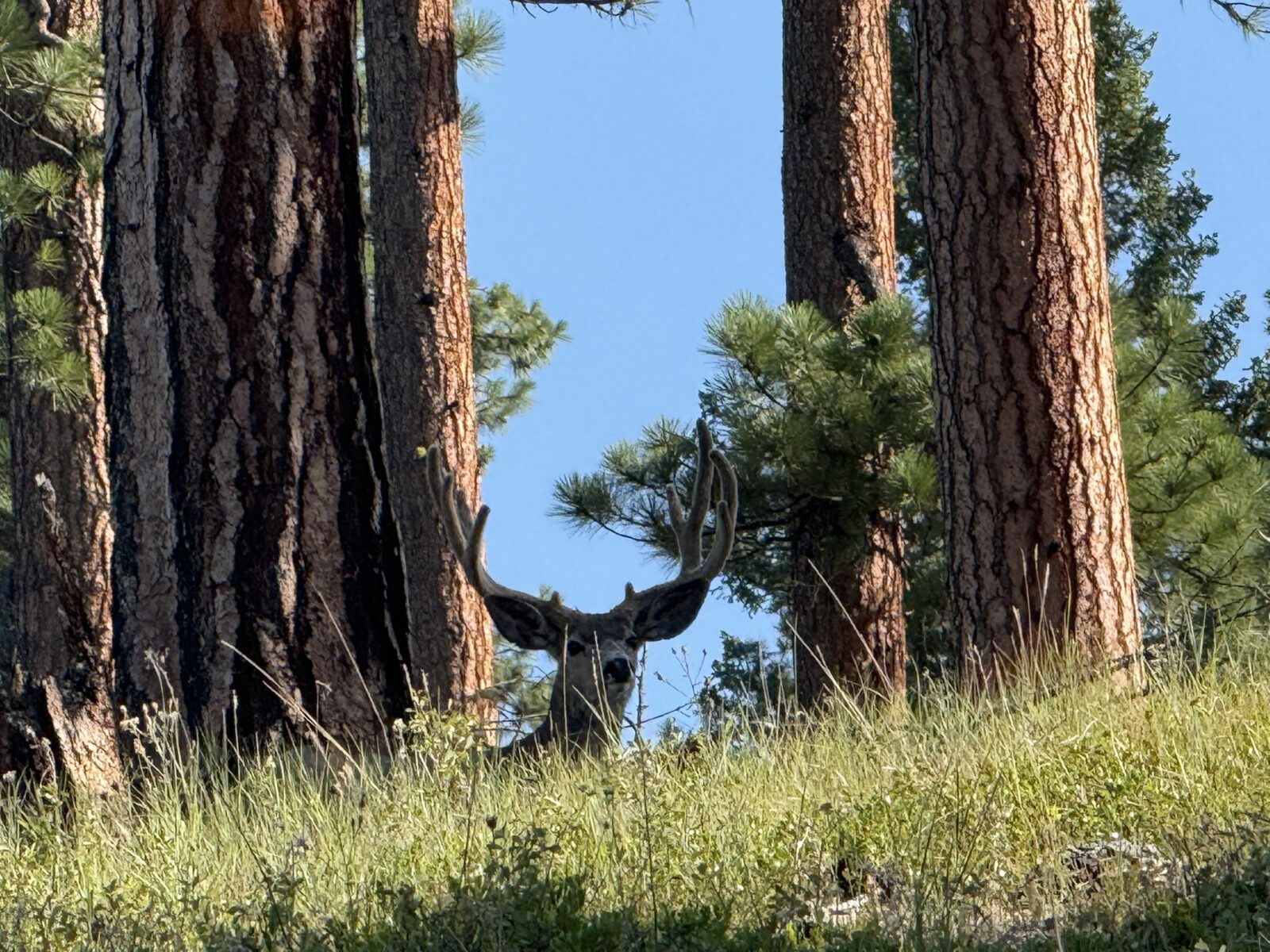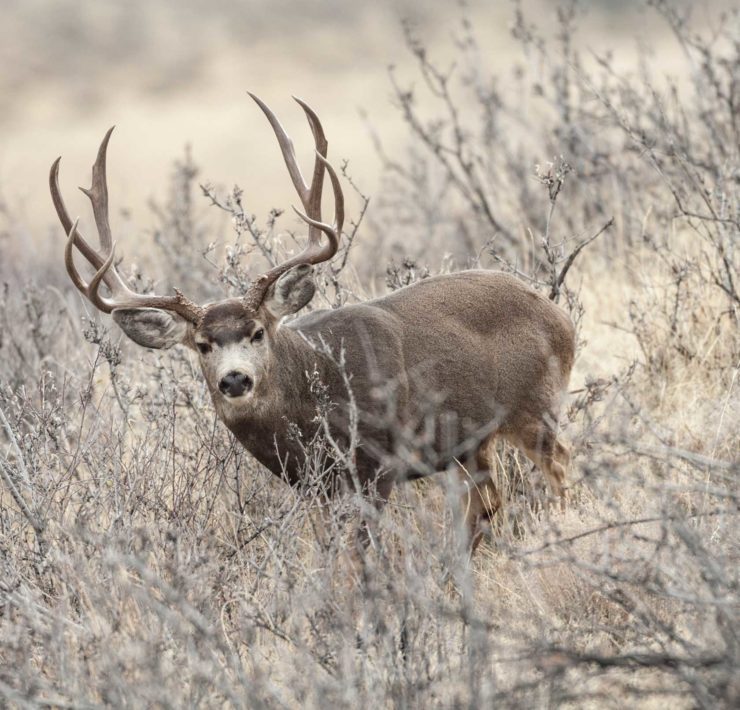Restoring Trophy Mule Deer Habitat in Montana’s Bitterroot National Forest

By: Karina Puikkonen
November 24, 2025
Deep in the rugged mountains of southwestern Montana, a vital multi-year habitat restoration project led by the Mule Deer Foundation and the U.S. Department of Agriculture (USDA), Forest Service continues to improve habitat in one of the state’s premier mule deer hunting districts. The Teepee Project has multiple phases that focus on hazardous fuels reduction in forests east of the town of Sula and directly adjacent to the Springer Memorial and Bonanza rural communities.
The first two forest treatments were completed on 1,200 acres this year, as part of this greater effort to secure the future for a western Montana mule deer population known to produce trophy bucks. The project is in Montana’s renowned Hunting District (HD) 270, which has long been a destination for hunters seeking once-in-a-lifetime bucks.
Decades of fire suppression and dense forest growth have decreased the quality of the mixed forest habitat deer and other wildlife, such as elk and bighorn sheep, depend on and have contributed to severe wildfires in the unit over the past decade. By creating healthier forest conditions, MDF and the USDA Forest Service are committed to mitigating this wildfire risk for the safety of local communities and for the future health of mule deer and all wildlife in this area.
A Dynamic Landscape for Western Montana’s Trophy Mule Deer
The numbers tell a contemplative story. Western Montana holds just 4% of the state’s mule deer population. East of the Continental Divide, vast grasslands and sagebrush expanses provide ideal mule deer habitat. But west of the divide, thick forests and challenging terrain create a fundamentally different landscape, one where every quality habitat area becomes critically important. This is what makes HD 270 so important.
HD 270 is a mountainous region with diverse terrain, including steep drainages, mixed conifer forests, and alpine meadows that have grown large deer. HD 270’s East Fork drainage provides essential winter range, productive summer forage, and secure migration corridors for mule deer moving between valley bottoms and high-elevation summer ranges. The district’s careful management approach issues just 30-50 tags annually, prioritizing sustainable trophy hunting while maintaining healthy herd genetics and robust population structure.
“When people think of Montana, they picture an area like this,” said Alex Elantri, MDF’s Regional Conservation Coordinator. “It’s a treasure trove of wildlife with great genetics and numbers. Most days you go in, you see mule deer, elk, and bighorn sheep.”

The most immediate danger to this landscape is the ever-present threat of lightning-caused wildfires, with Montana’s worst fire seasons occurring in just the last decade. The 2017 fire season, at that time, had been the most devastating to high-elevation forests since 1910. Record drought and high winds drove the largest number of fires ever recorded and acres (1.4 million) burned in the state’s history. The 2017 Lolo Peak Fire that sparked from lightning burned over 53,000 acres in the Lolo and Bitterroot National Forests where HD 270 is located. A mixture of wildfire severity left behind a patchy landscape with some areas completely burned and others beginning to regenerate.
The 2020 statewide fire season soon eclipsed 2017 as the worst in over 2,000 years. With this increasing risk of severe wildfire, the East Fork drainage and Teepee Creek areas of HD 270 became critical areas for fuels reduction and wildfire mitigation work.
The Race Against Fire: The Teepee Project
The Teepee Project began last summer, with contract hand crews thinning nearly 900 acres of forest and stacking the downed wood into piles on steep terrain along riparian areas. In late July, the Johnson Fire began just three miles south of the Springer Memorial Community. It wasn’t a threat to the project site at first, but when the Teepee Project was 40% complete, the fire jumped across the Bitterroot River, forcing Elantri to decide whether to continue or stop. He had spent four years fighting fires across the Southeast, Alaska, California, and the Midwest, and knew the warning signs. The decision to pause work wasn’t easy but it was necessary.
“This area is incredibly remote and rugged,” Elantri explained. “It’s a three-hour drive each way, with one way in and out. When you’re working in steep, mountainous terrain with contractors on site, you can’t take chances with wildfire.”
The fire became active and local evacuation orders were issued just a few days later. Once conditions improved, the crew returned to complete a total of 883 acres of critical habitat work. Elantri coordinated with local firefighters this past summer as a precaution prior to thinning and hand piling an additional 556 acres adjacent to the first project area. Luckily no fires ignited in the area, the additional acres were completed without disruption. The benefits became immediately visible when Elantri checked the unit the day after contractors finished their work.


“The deer were already there, feeding from the slash piles,” Elantri said. “Wildlife in this area are completely in tune with habitat changes, and they come back to use it incredibly quickly.”
This immediate response has been common on MDF projects. By thinning overgrown forests and creating openings, these treated forests become that mosaic of meadows, aspen stands, and open conifer forests that mule deer evolved to thrive in. These openings now provide the conditions for crucial forage such as shrubs, forbs, and grasses to regrow in an area that had been shaded out by decades of dense forest growth.
A Landscape-Level Approach
The active forest management work being done in HD 270 exemplifies the power of collaborative conservation. MDF has another 1,170 additional acres of habitat work planned for next year, showcasing its commitment to proactive, science-based conservation. The Bitterroot National Forest coordinates closely with Montana Fish, Wildlife & Parks (FWP) regional biologists to align habitat projects with wildlife population goals. As FWP works to develop a comprehensive mule deer management plan, HD 270 serves as a priority landscape where habitat improvements directly support population objectives.
This landscape-level approach also matters deeply to the many people who value this area. Nearby retiree and veteran communities like Springer Memorial and Bonanza can continue to live in this picturesque landscape, while hunters drawn to HD 270’s trophy potential can become invested stakeholders in the long-term sustainability of this habitat that has provided prized hunting opportunities. HD 270 shows that rural living, trophy hunting, and conservation aren’t contradictory goals. By maintaining quality habitat, managing forests carefully, and investing in landscape-scale restoration, this district offers a model for sustaining wildlife populations amid modern pressures. In an era of rapid change, that may be its greatest conservation value of all.
Join the Mule Deer Foundation and help us grow trophy bucks!




